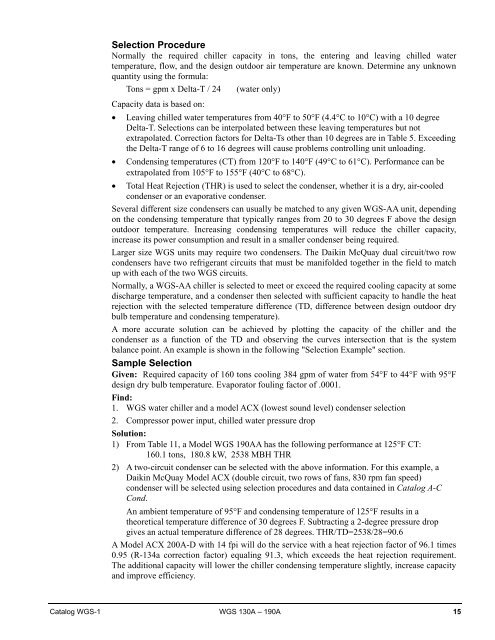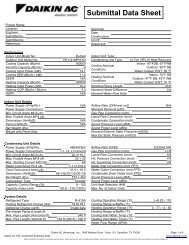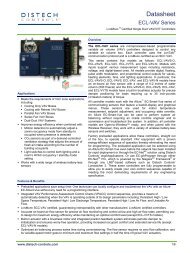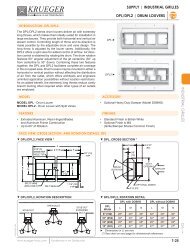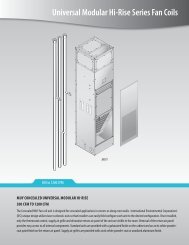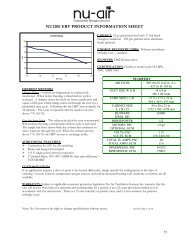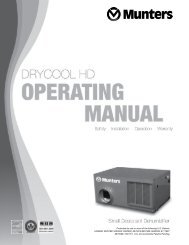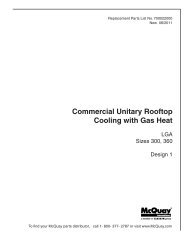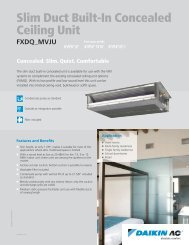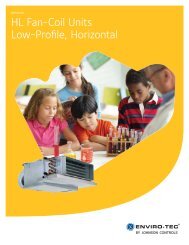Water-Cooled Condensers - HTS
Water-Cooled Condensers - HTS
Water-Cooled Condensers - HTS
Create successful ePaper yourself
Turn your PDF publications into a flip-book with our unique Google optimized e-Paper software.
Selection ProcedureNormally the required chiller capacity in tons, the entering and leaving chilled watertemperature, flow, and the design outdoor air temperature are known. Determine any unknownquantity using the formula:Tons = gpm x Delta-T / 24 (water only)Capacity data is based on: Leaving chilled water temperatures from 40F to 50F (4.4C to 10C) with a 10 degreeDelta-T. Selections can be interpolated between these leaving temperatures but notextrapolated. Correction factors for Delta-Ts other than 10 degrees are in Table 5. Exceedingthe Delta-T range of 6 to 16 degrees will cause problems controlling unit unloading. Condensing temperatures (CT) from 120F to 140F (49C to 61C). Performance can beextrapolated from 105F to 155F (40C to 68C). Total Heat Rejection (THR) is used to select the condenser, whether it is a dry, air-cooledcondenser or an evaporative condenser.Several different size condensers can usually be matched to any given WGS-AA unit, dependingon the condensing temperature that typically ranges from 20 to 30 degrees F above the designoutdoor temperature. Increasing condensing temperatures will reduce the chiller capacity,increase its power consumption and result in a smaller condenser being required.Larger size WGS units may require two condensers. The Daikin McQuay dual circuit/two rowcondensers have two refrigerant circuits that must be manifolded together in the field to matchup with each of the two WGS circuits.Normally, a WGS-AA chiller is selected to meet or exceed the required cooling capacity at somedischarge temperature, and a condenser then selected with sufficient capacity to handle the heatrejection with the selected temperature difference (TD, difference between design outdoor drybulb temperature and condensing temperature).A more accurate solution can be achieved by plotting the capacity of the chiller and thecondenser as a function of the TD and observing the curves intersection that is the systembalance point. An example is shown in the following "Selection Example" section.Sample SelectionGiven: Required capacity of 160 tons cooling 384 gpm of water from 54F to 44F with 95Fdesign dry bulb temperature. Evaporator fouling factor of .0001.Find:1. WGS water chiller and a model ACX (lowest sound level) condenser selection2. Compressor power input, chilled water pressure dropSolution:1) From Table 11, a Model WGS 190AA has the following performance at 125F CT:160.1 tons, 180.8 kW, 2538 MBH THR2) A two-circuit condenser can be selected with the above information. For this example, aDaikin McQuay Model ACX (double circuit, two rows of fans, 830 rpm fan speed)condenser will be selected using selection procedures and data contained in Catalog A-CCond.An ambient temperature of 95F and condensing temperature of 125F results in atheoretical temperature difference of 30 degrees F. Subtracting a 2-degree pressure dropgives an actual temperature difference of 28 degrees. THR/TD=2538/28=90.6A Model ACX 200A-D with 14 fpi will do the service with a heat rejection factor of 96.1 times0.95 (R-134a correction factor) equaling 91.3, which exceeds the heat rejection requirement.The additional capacity will lower the chiller condensing temperature slightly, increase capacityand improve efficiency.Catalog WGS-1 WGS 130A – 190A 15


